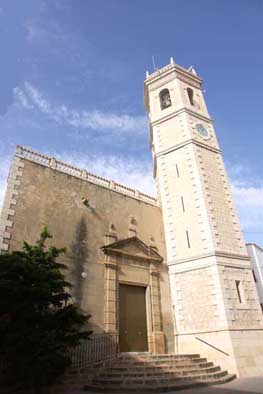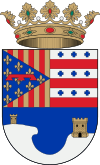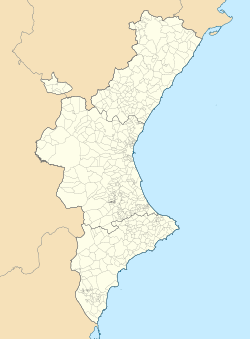Teulada, Spain facts for kids
Quick facts for kids
Teulada
|
||
|---|---|---|

Church of St. Catherine.
|
||
|
||
| Country | ||
| Autonomous community | ||
| Province | Alicante | |
| Comarca | Marina Alta | |
| Judicial district | Dénia | |
| Area | ||
| • Total | 32.24 km2 (12.45 sq mi) | |
| Elevation | 185 m (607 ft) | |
| Population
(2018)
|
||
| • Total | 10,722 | |
| • Density | 332.57/km2 (861.35/sq mi) | |
| Time zone | UTC+1 (CET) | |
| • Summer (DST) | UTC+2 (CEST) | |
| Postal code |
03724, 03725
|
|
| Official language(s) | Valencian, Spanish | |
Teulada is a charming coastal town in Spain. It sits on the famous Costa Blanca. You can find it about 3 kilometers north of Junction 63 on the A7 E-15 motorway. It is also located along the N-332 coast road.
Unlike its busy neighbors like Calp and Benidorm, Teulada has special rules. The town council made laws to keep buildings from being too tall. They also protect the beautiful pine trees. These trees cover the valleys leading to the coast, especially near Moraira.
Contents
Discover Teulada: A Spanish Coastal Town
Teulada's Rich History
The very first signs of people living here are super old! They date back to the Upper Paleolithic Period. This was about 15,000 to 20,000 years BC. Scientists found remains in a cave on the Cap d’Or headland.
Teulada was officially started in the year 1386. In the 1500s, the town needed strong defenses. This was because of constant attacks from Barbary pirates. These pirates were sea raiders from North Africa. A lookout tower on the headland still stands today. It has been partly fixed up.
The town's economy used to be mostly farming. This was influenced by a long period when the Moors lived there. You can still see walled terraces on the hillsides. These terraces helped grow almonds, grapes, and citrus fruits.
How Teulada's Economy Works
Today, tourism is the biggest part of Teulada's economy. The construction industry also helps it grow. Many people from other European countries live here. Most are from England, Germany, and the Netherlands.
This group of non-Spanish residents has become very important. In 1999, a political party called The Moraira Party won local elections. This party was mostly made up of these foreign residents. Since then, the town has invested a lot in local facilities. This is especially true in the coastal area of Moraira.
Tourism and Local Life
Even with all the changes, Teulada still keeps its Spanish traditions. The street market on Wednesday mornings is a great example. Many fiestas (festivals) happen all year. These events show off Spanish customs. They also feature some of the best firework displays on the coast.
Places to See in Teulada
There are many interesting places to visit in Teulada:
- The Parish church of St. Catherine: This church was built in the early 16th century.
- Sala de Jurats i Justícia de Teulada: This historic building dates back to the 17th century.
- Castle of Moraira: A historic castle near the coast.
- Cap d'Or Tower: This lookout tower was built in 1563 to watch for pirates.
- Hermitages of St. Vincent Ferrer, Divina Pastora, and Fonta Santa: These are small, historic chapels.
Fun Festivals and Traditions
Teulada has many exciting local fiestas (festivals):
- San Vincente Ferrer: This festival happens every Monday after Easter. It celebrates the town's Patron Saint.
- Moros y Cristianos (Moors and Christians): This lively festival takes place during the second week of June. It re-enacts historical battles.
- Festa del Moscatell: Held on the first Saturday in September. This festival celebrates the local Moscatel grape.
- Santa Catalina: Celebrated on November 25th.
See also
 In Spanish: Teulada para niños
In Spanish: Teulada para niños





